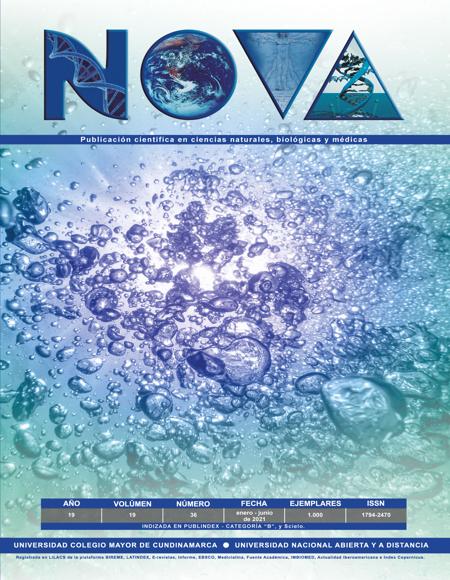Fracture resistance of analogally made dental crowns vs cad-cam technology : in vitro study.
Resistencia a la fractura de coronas dentales fabricadas análogamente vs tecnología cad-cam : estudio In vitro.
NOVA by http://www.unicolmayor.edu.co/publicaciones/index.php/nova is distributed under a license creative commons non comertial-atribution-withoutderive 4.0 international.
Furthermore, the authors keep their property intellectual rights over the articles.
Show authors biography
Background. The fracture resistance of the crowns may have an influence on their appearance, according to the method of making them, either analogously or by means of Cad-Cam technology. Objective. To compare the resistance to the fracture of the individual crowns made by two manufacturing methods, under computer-aided design and computerized manufacturing (CAD-CAM) and injected. Methods. In vitro study. Sample size 20 crowns in two groups: 10 crowns using CAD-CAM technology and 10 crowns injected. Crowns were subjected to compressive loads in a universal testing machine, with a speed of 1mm / min and a cell load of 5kN until obtaining the maximum bill for these. Data were statistically analyzed using the Shapiro Wilk tests, Mann Whitney p = 0.05. Results. Crowns manufactured by Cad-Cam obtained a minimum of 602.5 Newton and a maximum of 1093 Newton, while the crowns manufactured analogously obtained a minimum of 525.2 Newton and a maximum of 1773 Newton in the experiment with the machine Universal test to achieve their fracture. A significant difference was obtained in the invoice resistance test between both manufacturing methods (p <0.001). Conclusion. Pressed Lithium Disilicate crowns obtained higher fracture resistance than crowns under design and manufacturing by computer (CAD-CAM).
Article visits 349 | PDF visits 224
Downloads
- R. C. Olley, M. Andiappan, and P. M. Frost, “An up to 50-year follow-up of crown and veneer survival in a dental practice,” J. Prosthet. Dent., vol. 119, no. 6, pp. 935–941, Jun. 2018, doi: 10.1016/j.prosdent.2017.06.009.
- S. Rinke, “Clinical Evaluation of Chairside-Fabricated Partial Crowns Made of Zirconia Reinforced Lithium Silicate Ceramic - 2-Year-Results,” Eur. J. Prosthodont. Restor. Dent., vol. 28, no. 1, pp. 36–42, Mar. 2020, doi: 10.1922/EJPRD_2001Rinke07.
- M. Turon-Vinas and M. Anglada, “Strength and fracture toughness of zirconia dental ceramics,” Dent. Mater. Off. Publ. Acad. Dent. Mater., vol. 34, no. 3, pp. 365–375, 2018, doi: 10.1016/j.dental.2017.12.007.
- Y. Zhang and J. R. Kelly, “Dental Ceramics for Restoration and Metal Veneering,” Dent. Clin. North Am., vol. 61, no. 4, pp. 797–819, 2017, doi: 10.1016/j.cden.2017.06.005.
- S. E. Elsaka and A. M. Elnaghy, “Mechanical properties of zirconia reinforced lithium silicate glass-ceramic,” Dent. Mater. Off. Publ. Acad. Dent. Mater., vol. 32, no. 7, pp. 908–914, 2016, doi: 10.1016/j.dental.2016.03.013.
- A. Goujat et al., “Mechanical properties and internal fit of 4 CAD-CAM block materials,” J. Prosthet. Dent., vol. 119, no. 3, pp. 384–389, Mar. 2018, doi: 10.1016/j.prosdent.2017.03.001.
- A. Awada and D. Nathanson, “Mechanical properties of resin-ceramic CAD/CAM restorative materials,” J. Prosthet. Dent., vol. 114, no. 4, pp. 587–593, Oct. 2015, doi: 10.1016/j.prosdent.2015.04.016.
- A. Furtado de Mendonca, M. Shahmoradi, C. V. D. de Gouvêa, G. M. De Souza, and A. Ellakwa, “Microstructural and Mechanical Characterization of CAD/CAM Materials for Monolithic Dental Restorations,” J. Prosthodont. Off. J. Am. Coll. Prosthodont., vol. 28, no. 2, pp. e587–e594, Feb. 2019, doi: 10.1111/jopr.12964.
- S.-H. Kang, J. Chang, and H.-H. Son, “Flexural strength and microstructure of two lithium disilicate glass ceramics for CAD/CAM restoration in the dental clinic,” Restor. Dent. Endod., vol. 38, no. 3, pp. 134–140, Aug. 2013, doi: 10.5395/rde.2013.38.3.134.
- F. Martínez-Rus, A. Ferreiroa, M. Özcan, J. F. Bartolomé, and G. Pradíes, “Fracture resistance of crowns cemented on titanium and zirconia implant abutments: a comparison of monolithic versus manually veneered all-ceramic systems,” Int. J. Oral Maxillofac. Implants, vol. 27, no. 6, pp. 1448–1455, Dec. 2012.
- P. Magne and R. Cheung, “Numeric simulation of occlusal interferences in molars restored with ultrathin occlusal veneers,” J. Prosthet. Dent., vol. 117, no. 1, pp. 132–137, Jan. 2017, doi: 10.1016/j.prosdent.2016.07.008.
- K. Nishigawa, E. Bando, and M. Nakano, “Quantitative study of bite force during sleep associated bruxism,” J. Oral Rehabil., vol. 28, no. 5, pp. 485–491, May 2001, doi: 10.1046/j.1365-2842.2001.00692.x.
- M. Zahran, O. El-Mowafy, L. Tam, P. A. Watson, and Y. Finer, “Fracture strength and fatigue resistance of all-ceramic molar crowns manufactured with CAD/CAM technology,” J. Prosthodont. Off. J. Am. Coll. Prosthodont., vol. 17, no. 5, pp. 370–377, Jul. 2008, doi: 10.1111/j.1532-849X.2008.00305.x.
- Y. Liu, Y. Wang, Q. Zhang, Y. Gao, and H. Feng, “[Fracture reliability of zirconia all-ceramic crown according to zirconia coping design],” Beijing Da Xue Xue Bao, vol. 46, no. 1, pp. 71–75, Feb. 2014.
- R. Daniel Bacigalupe and R. Ernesto Villablanca, “Uso de coronas sistema cad-cam en implantes osteointegrados,” Rev. Médica Clínica Las Condes, vol. 25, no. 1, pp. 158–165, Jan. 2014, doi: 10.1016/S0716-8640(14)70022-7.
- M. Al-Akhali, M. S. Chaar, A. Elsayed, A. Samran, and M. Kern, “Fracture resistance of ceramic and polymer-based occlusal veneer restorations,” J. Mech. Behav. Biomed. Mater., vol. 74, pp. 245–250, 2017, doi: 10.1016/j.jmbbm.2017.06.013.
- S. Varga, S. Spalj, M. Lapter Varga, S. Anic Milosevic, S. Mestrovic, and M. Slaj, “Maximum voluntary molar bite force in subjects with normal occlusion,” Eur. J. Orthod., vol. 33, no. 4, pp. 427–433, Aug. 2011, doi: 10.1093/ejo/cjq097.
- I. Sailer, G. I. Benic, V. Fehmer, C. H. F. Hämmerle, and S. Mühlemann, “Randomized controlled within-subject evaluation of digital and conventional workflows for the fabrication of lithium disilicate single crowns. Part II: CAD-CAM versus conventional laboratory procedures,” J. Prosthet. Dent., vol. 118, no. 1, pp. 43–48, Jul. 2017, doi: 10.1016/j.prosdent.2016.09.031.






